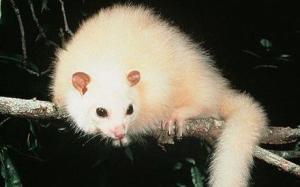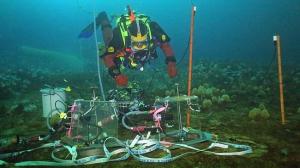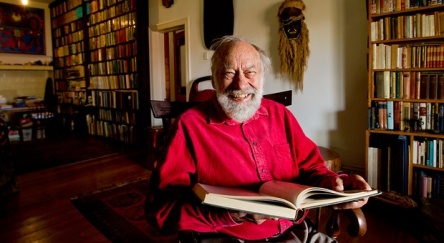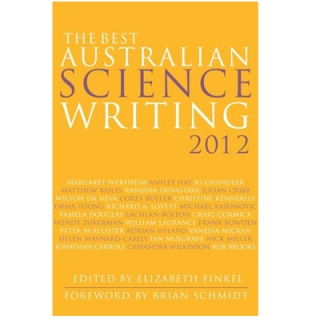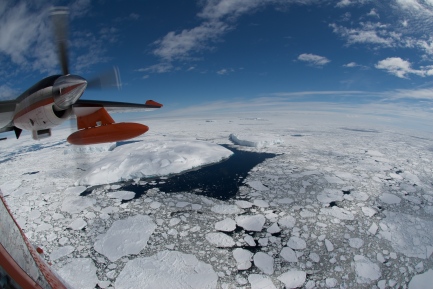THE MONTHLY: APRIL 2023
CLIMATE JUSTICE IN THE PACIFIC
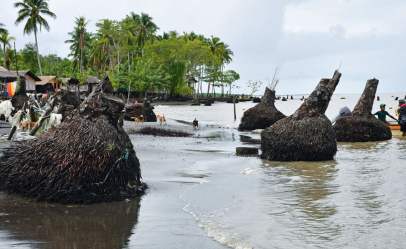 “It strikes me, after 14 years (on and off) reporting from all over PNG, that climate damage is the most tangible return many grassroots people have ever known on those gazillions of gallons of extracted fossil-fuel wealth.” I spent a couple of weeks last year visiting three villages in PNG dealing with climate impacts – two coastal, one in the highlands. My aim was to try to share the stories of ordinary people dealing with rising tides and extreme, shifting weather – people who have little information and zero resources. And then to think about what climate justice might look like if it is to find its way to these people. The article is published this month in The Monthly. Thanks to the dozens of people who shared their stories and knowledge, many who are not named in the story. And to the Walkley Foundation Sean Dorney Pacific Journalism Grant. Link is here: https://www.themonthly.com.au/issue/2023/april/jo-chandler/climate-justice-pacific
“It strikes me, after 14 years (on and off) reporting from all over PNG, that climate damage is the most tangible return many grassroots people have ever known on those gazillions of gallons of extracted fossil-fuel wealth.” I spent a couple of weeks last year visiting three villages in PNG dealing with climate impacts – two coastal, one in the highlands. My aim was to try to share the stories of ordinary people dealing with rising tides and extreme, shifting weather – people who have little information and zero resources. And then to think about what climate justice might look like if it is to find its way to these people. The article is published this month in The Monthly. Thanks to the dozens of people who shared their stories and knowledge, many who are not named in the story. And to the Walkley Foundation Sean Dorney Pacific Journalism Grant. Link is here: https://www.themonthly.com.au/issue/2023/april/jo-chandler/climate-justice-pacific
GRIFFITH REVIEW: APRIL 2022
BURIED TREASURE: JOURNEY INTO DEEP TIME
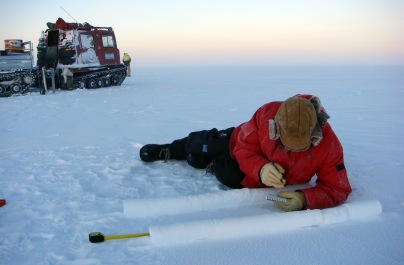 In 2007 and again in 2008/09 I was lucky enough to spend time in Antarctica researching stories on Australia’s scientific work there, reporting on changes to the polar ice and Southern Ocean, and what they can tell us about our climate past and our future. In the years since I have returned to the science many times as knowledge has grown, reporting on the melting of ice sheets, the movement of glaciers, the implications for global sea level rise, and a host of other issues. I’ve developed knowledge and relationships I cherish – it’s a gratifying thing to do as a reporter, to circle back, ideally with new stories informed and enriched by previous work. One of the stories I’ve followed closely over those years is the quest to recover more than one million years of Earth’s climate history by drilling a hole deep into the ice sheet. It’s an epic and urgent mission. I was thrilled to be part of this Antarctic edition of Griffith Review, and to produce this piece with the ever-patient and brilliant guidance of editor Ashley Hay. This was her last edition of GR, and my third longform story for her over the years. You can find the piece in the Griffith Review 77 Real Cool World: Link here: https://www.griffithreview.com/articles/buried-treasure/
In 2007 and again in 2008/09 I was lucky enough to spend time in Antarctica researching stories on Australia’s scientific work there, reporting on changes to the polar ice and Southern Ocean, and what they can tell us about our climate past and our future. In the years since I have returned to the science many times as knowledge has grown, reporting on the melting of ice sheets, the movement of glaciers, the implications for global sea level rise, and a host of other issues. I’ve developed knowledge and relationships I cherish – it’s a gratifying thing to do as a reporter, to circle back, ideally with new stories informed and enriched by previous work. One of the stories I’ve followed closely over those years is the quest to recover more than one million years of Earth’s climate history by drilling a hole deep into the ice sheet. It’s an epic and urgent mission. I was thrilled to be part of this Antarctic edition of Griffith Review, and to produce this piece with the ever-patient and brilliant guidance of editor Ashley Hay. This was her last edition of GR, and my third longform story for her over the years. You can find the piece in the Griffith Review 77 Real Cool World: Link here: https://www.griffithreview.com/articles/buried-treasure/
THE GUARDIAN: DECEMBER 2021
THE FEAR OF THIS VACCINE IS REAL: HOW PNG’S COVID STRATEGY WENT SO WRONG
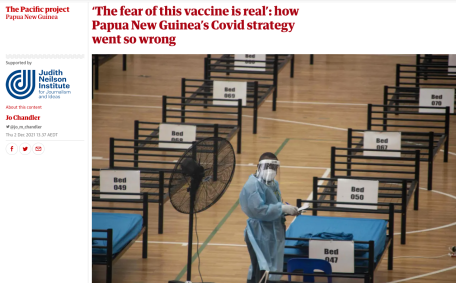 In December 2021, I was asked by The Guardian to investigate Papua New Guinea’s frighteningly low vaccination rate – among the lowest in the world. I had been hearing horror stories about the spread of the disease through my networks. As with everything in PNG, it’s complicated. And difficult to get across from my home office in Melbourne. But with the help of a collection of experts in health and society, mostly inside the country and a few outside, this article came together with a few ideas identifying the problems and some potential solutions. The story was re-published in early January as an audio report, recorded in the UK for distribution across the Guardian’s various international mastheads. This link is to the audio take, but within it you can go to the original written version.
In December 2021, I was asked by The Guardian to investigate Papua New Guinea’s frighteningly low vaccination rate – among the lowest in the world. I had been hearing horror stories about the spread of the disease through my networks. As with everything in PNG, it’s complicated. And difficult to get across from my home office in Melbourne. But with the help of a collection of experts in health and society, mostly inside the country and a few outside, this article came together with a few ideas identifying the problems and some potential solutions. The story was re-published in early January as an audio report, recorded in the UK for distribution across the Guardian’s various international mastheads. This link is to the audio take, but within it you can go to the original written version.
GRIFFITH REVIEW: FEBRUARY 2021
THE CLIMATE COVID COLLISION: TALES FROM THE FRONT LINE
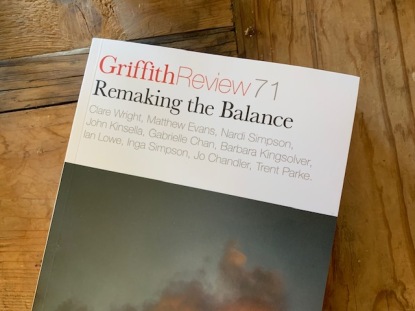 I was supposed to be researching matters of climate justice in the Pacific. Instead over the long Melbourne lockdown in the pandemic winter of 2020, I was in my home nursing a bad case of Black Summer grief. This essay captures my attempts to wrangle that into something useful, going back to scientific experts who are long-haul contacts, digging deep. The piece is published in the latest edition of the quarterly journal Griffith Review: Remaking the Balance. Read it here: https://www.griffithreview.com/articles/tales-from-the-frontline/
I was supposed to be researching matters of climate justice in the Pacific. Instead over the long Melbourne lockdown in the pandemic winter of 2020, I was in my home nursing a bad case of Black Summer grief. This essay captures my attempts to wrangle that into something useful, going back to scientific experts who are long-haul contacts, digging deep. The piece is published in the latest edition of the quarterly journal Griffith Review: Remaking the Balance. Read it here: https://www.griffithreview.com/articles/tales-from-the-frontline/
This essay was selected as runner-up for the 2021 UNSW Bragg Prize for Science Writing.
THE MONTHLY: APRIL 2019
DRY AT THE MOUTH: WITNESSING THE ECOLOGICAL COLLAPSE OF THE COORONG
 In this story, once again I circle back to revisit and deepen previous reporting. I’ve tagged along with University of Adelaide biologist and bird expert Dr David Paton’s annual summer surveys of the sublime Coorong area of South Australia several times over the years, most memorably taking my kids along as volunteers when they were small. They plucked tiny birds out of mist nets and weighed them, sifted the water for tiny larvae, released pygmy possums out of field traps, and after the washing up was done in the field camp, did jigsaws and talked about the wild world with actual scientists. It was a beautiful time in a magical place, but already we felt we were witnessing its vanishing. Worst fears are being realised. My story for The Monthly is here.
In this story, once again I circle back to revisit and deepen previous reporting. I’ve tagged along with University of Adelaide biologist and bird expert Dr David Paton’s annual summer surveys of the sublime Coorong area of South Australia several times over the years, most memorably taking my kids along as volunteers when they were small. They plucked tiny birds out of mist nets and weighed them, sifted the water for tiny larvae, released pygmy possums out of field traps, and after the washing up was done in the field camp, did jigsaws and talked about the wild world with actual scientists. It was a beautiful time in a magical place, but already we felt we were witnessing its vanishing. Worst fears are being realised. My story for The Monthly is here.
THE LANCET: DECEMBER 2018
FIGHTING A POLIO OUTBREAK IN PNG
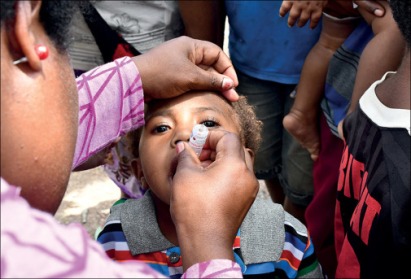 When I went to Nigeria in April 2017 to research a story (for The Atlantic and Undark) on the efforts there to stamp out polio, I couldn’t help but be grateful – and a bit mystified – that the disease had been absent so long from Papua New Guinea. With only a small proportion of the country having access to proper toilets and clean water, and collapsing low vaccination rates, PNG appeared vulnerable to this wily and opportunistic virus. And then, in 2018, polio returned after an 18 year absence. During my research trip in September that year, I filed this report for The Lancet’s World Report section on the campaign to stop the spread. The story is available free, though you may be required to register an email address to get access: Link is here.
When I went to Nigeria in April 2017 to research a story (for The Atlantic and Undark) on the efforts there to stamp out polio, I couldn’t help but be grateful – and a bit mystified – that the disease had been absent so long from Papua New Guinea. With only a small proportion of the country having access to proper toilets and clean water, and collapsing low vaccination rates, PNG appeared vulnerable to this wily and opportunistic virus. And then, in 2018, polio returned after an 18 year absence. During my research trip in September that year, I filed this report for The Lancet’s World Report section on the campaign to stop the spread. The story is available free, though you may be required to register an email address to get access: Link is here.
THE ATLANTIC: OCTOBER 2017
THE THREAT OF POLIO IN THE BADLANDS OF BOKO HARAM
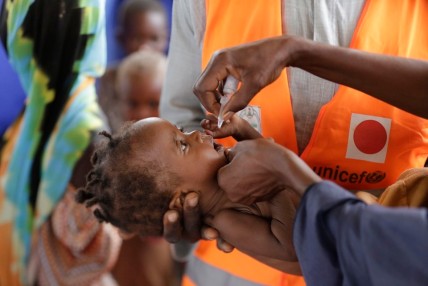 It’s costing more than $1 billion a year to hang onto the ground won on polio and, inch by inch, to overcome religious resistance, cultural mistrust, and a backlash within vulnerable communities where the disease has faded from memory and more immediate crises—other diseases, lack of food, political strife—can seem a higher priority than polio vaccine. If the war on polio is to be won, it must run the gamut of all these—as well as the terrorizing resistance of violent men with guns. Link here to The Atlantic. This story was commissioned and published originally by Undark, link here.
It’s costing more than $1 billion a year to hang onto the ground won on polio and, inch by inch, to overcome religious resistance, cultural mistrust, and a backlash within vulnerable communities where the disease has faded from memory and more immediate crises—other diseases, lack of food, political strife—can seem a higher priority than polio vaccine. If the war on polio is to be won, it must run the gamut of all these—as well as the terrorizing resistance of violent men with guns. Link here to The Atlantic. This story was commissioned and published originally by Undark, link here.
THE MONTHLY MAGAZINE: MARCH 2017
THE TOTTEN HOTS UP
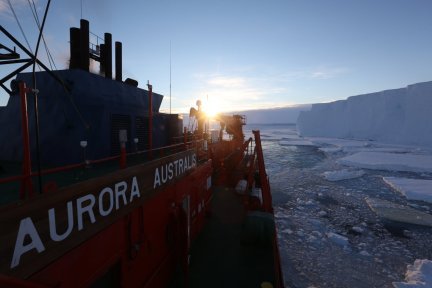 Throughout the geologically brief climate sweet spot that human civilisation has enjoyed, spared the orbital meanderings that have spun our planet in and out of ice ages, Totten’s flow has hummed obligingly in neutral. Put simply, it has maintained its “glacial mass balance”, whereby snowfall coming in and ice flowing out equals a negligible shift in sea levels. Now it appears Totten has slipped into gear. Link here.
Throughout the geologically brief climate sweet spot that human civilisation has enjoyed, spared the orbital meanderings that have spun our planet in and out of ice ages, Totten’s flow has hummed obligingly in neutral. Put simply, it has maintained its “glacial mass balance”, whereby snowfall coming in and ice flowing out equals a negligible shift in sea levels. Now it appears Totten has slipped into gear. Link here.
This story was awarded the Melbourne Press Club Quill Award for Best Feature.
THE MONTHLY MAGAZINE: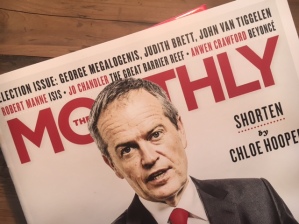 JUNE 2016
JUNE 2016
GRAVE BARRIER REEF
‘We were diving in dissolving reef. The water had this terrible green ghostly quality – it was like diving in ectoplasm. It was awful. And essentially it was dying coral.” In the June edition of The Monthly I have a long piece on the devastating coral bleaching now playing out on the Great Barrier Reef. At the same time as news emerges that
the Australian Government has censored a UN report on the condition of the Reef and other iconic World Heritage sites for fear of frightening off tourists, scientists talk to me about their distress. What – if anything – can save the Great Barrier Reef? Link here.
COSMOS MAGAZINE: JANUARY 2016 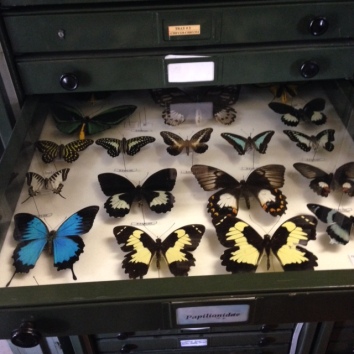
IN THE FOOTSTEPS OF WALLACE
Vojtech Novotny is a Czech entomologist who first travelled to Papua New Guinea 20 years ago. He came for the insects. He stayed for the people. Having heard much about him over the years, it was a thrill to visit his laboratory and field sites in Madang. The profile I’ve written is published in the December/January edition of Cosmos Magazine. He talks about his scientific journey, and his reflections on the precarious fate of the PNG tropical forests. Link is here.
THE MONTHLY MAGAZINE: MAY 2015
 GUT FEELINGS
GUT FEELINGS
‘You are very atypical for a human.’ This was the verdict of the microbiology team which evaluated the microbial population in my gut. This article for the special 10th anniversary edition of The Monthly explores the exploding medical frontier of the microbiome, ‘a seething ecosystem that has to be kept in balance and fed and maintained’. In the past few years new technology has delivered the step change equivalent of a telescope to explore our microbial dark matter, finally allowing science to begin to understand its potentially profound influence on our health and wellbeing. Now unlocked! You can find it here: https://www.themonthly.com.au/issue/2015/may/1430402400/jo-chandler/gut-feelings
NEW SCIENTIST: JULY 2014
GHOST OF THE CLOUD FOREST
(UPDATE: This story was republished by New Scientist in September 2016 as part of their ‘Best Of’ series ‘Living Planet‘.)
In this feature for New Scientist, I join a team from James Cook University which is closely monitoring the impacts of climate change in Far North Queensland’s ancient cloud forests. We enter Australia’s lost world of species marooned by evolution to meet one of its rarest, a creature uniquely vulnerable to climate change – the white lemuroid possum, the endangered polar bear of the tropics. (Sorry, subs required)- Link here
YALE ENVIRONMENT 360 April 2014
Continuing my long interest in Antarctic field science, this report explains an epic and challenging experiment under the Antarctic ice. The team set up chambers on the sea floor near Casey station in an effort to monitor the impacts of ocean acidification in the polar regions, where it is expected to feel the ecological impacts of these changes in ocean chemistry hard, fast and soon. This is an icy variation of the same experiment I witnessed on Heron Island on the Great Barrier Reef a couple of years ago, and reported for The Age. (See report below.) And for an update on how it all went, see this report by the Australian Antarctic Division.
THE GLOBAL MAIL, 13 NOVEMBER 2012
THE LAST LAUGHING DEATH
(UPDATE: IN APRIL/MAY EDITION OF COSMOS MAGAZINE, AN EDITED AND UPDATED VERSION OF THIS STORY: SOLVING THE MYSTERY OF THE LAUGHING DISEASE.)
After 55 years, the final patrol for cases of the mysterious ‘laughing death’ in remote Papua New Guinea has returned from the highlands. From this pursuit came Nobel-winning science, clues to ‘mad cow’ and insights into Alzheimer’s disease. It also revealed a little bit of cannibal hidden in us all.
‘The father, or a close relative, would hold the head, and I would take the top of the skull off with a bone handsaw. It would take maybe 20 minutes… like cutting an avocado. I would go to particular parts of the brain… take out small cubes … Then I’d take the whole brain out and put it in a bucket full of formalin and cotton wool so it wouldn’t be deformed. Then I put the skull cap back on, and sewed up. Then we said goodbye… gave everyone a hug, and took off. I did this five times. It was enough.”
To read the full story: https://web.archive.org/web/20150318111247/http://www.theglobalmail.org/feature/the-last-laughing-death/470/index.html
FEELING THE HEAT: BOOK EXTRACT PUBLISHED IN THE AGE 2011
STORMFRONT (Winner UNSW Bragg Prize for Science Writing, 2012)
‘Today I begin a journey south, deep south, abandoning family to share a pure, white Christmas with a group of strangers at the end of the earth. A place with no economy, no shopping crowds, no shortage of parking, no avenues of glass-encased, climate-controlled malls. A place where the natural breath and pulse of the planet can still be felt. First a plane to Hobart, then another to Antarctica, climbing down into the high latitudes until the lines of longitude converge and we fall off the map defining the habitable world.’
– Judges’ Commendation: ‘Masterful narrative, which transformed science from a stultifying polemic to an engaging personal story’.
The Age, 3 January, 2010
FRONTIER SCIENTISTS TRACK WHALES IN THE ICE
‘At the mid-way point of this season’s planned 95 hours of survey, ”we are seeing a lot fewer whales than last year,” says (Dr Natalie) Kelly. ”Perhaps it is because the sea ice is incredibly dense this year outside Casey. We’re also seeing a lot fewer penguins in the water and on ice floes, which may relate to the krill population – perhaps the peak has been delayed or it’s not in the levels it has been in the last couple of years. Last year we saw 40 minkes in one area alone and loads of penguins. Definitely something’s going on, but as we’re not measuring krill or penguins directly, we can only really infer from what we are seeing.”’
To read the full story: http://www.theage.com.au/national/frontier-scientists-track-whales-in-the-ice-20100103-lnbi.html#ixzz2cxfw5ZrS
The Age 23 May, 2010
UNDERWATER LAB THE FIRST TO PLOT IMPACT OF CLIMATE CHANGE ON REEF
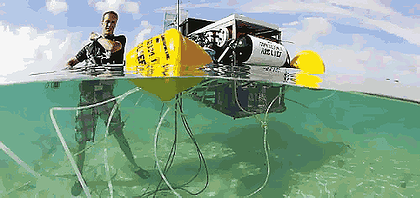 ‘The Heron Island experiment assumes a future with seawater twice as acidic as today, a more conservative take than published business-as-usual scenarios, which put the increase at 150 per cent by 2100. The question scientists are racing to answer is what a more acidic environment will mean for the tiny shelled zooplankton on which the marine food chain depends, and for the skeletons corals build into reefs.’
‘The Heron Island experiment assumes a future with seawater twice as acidic as today, a more conservative take than published business-as-usual scenarios, which put the increase at 150 per cent by 2100. The question scientists are racing to answer is what a more acidic environment will mean for the tiny shelled zooplankton on which the marine food chain depends, and for the skeletons corals build into reefs.’
To read the full story: http://www.theage.com.au/environment/climate-change/underwater-lab-the-first-to-plot-impact-of-climate-change-on-reefs-20100523-w3z7.html#ixzz2cxiPKMLt
